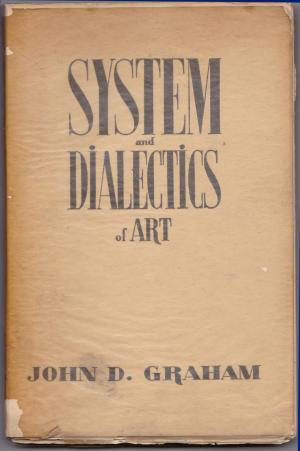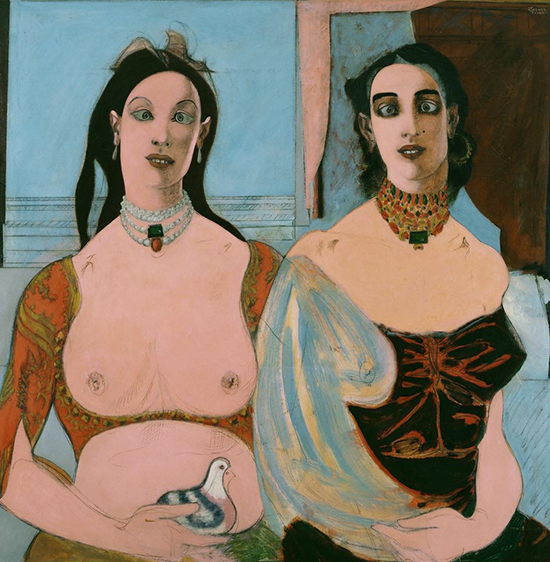He spoke as many as 12 languages, had five wives, influenced Jackson Pollock and lived in Southampton. What’s not to like?
John D. Graham, né Ivan Gratianovitch Dombrowsky, is the subject of a scholarly show at the Parrish Art Museum in Water Mill curated by Parrish Curator of Art and Education Alicia Longwell, Ph.D., along with guest curator Karen Wilkin and consulting curator William C. Agee. At the outset, this exhaustively researched exhibition brings linear clarity to a difficult Modernist star and is an academic achievement one would more likely expect to see at the Metropolitan Museum of Art, and not a regional museum.
This is not to degrade the efforts of regional museums, but to acknowledge that typically they lack the staff and resources to put together a comprehensive show on a historically important artist along with an authoritative catalogue. Assisting the Parrish, in this regard, was the fact Graham was the subject of Longwell’s 2007 Ph.D. dissertation at the Graduate Center, CUNY, which is where the research and contacts were mined.
.

John D. Graham with Primitive Artworks.
.
Early Modernism in painting, loosely defined as artwork seeking an essentialism constructed between the late 19th century up until WWII, was an intellectual adventure of the first order, having its manifestation in philosophy, poetry, sculpture, music and other forms of reflection. The task was, as poet Ezra Pound wrote in 1937, “Make it new.”
The first thing that stands out when reviewing Graham’s 50-year career is that he always seemed to be in the middle of it: Johnny-on-the-spot decade after decade. As modernism morphed from one style to another, there he is, working and publishing shoulder to shoulder with the primary players of any period.
Graham was born in Kiev, Ukraine in 1886. He was trained originally as a lawyer and served in the Russian army during WWI. He was imprisoned as a counter-revolutionary during the Bolshevik revolution and later escaped the European mayhem by emigrating in 1920 to the United States, where he began calling himself “John D. Graham.” Soon after he entered the Arts Students League of New York, an older art school on 57th Street in Manhattan, where he learned about painting. He quickly established himself as a painter, curator, and art critic, shuttling back and forth to Europe as the dialog shifted here and there, often supporting himself by reselling primitive sculpture and antiques for American dealers and collectors.
Ever shoring up his street cred as the go-to man in modern thought in the 1930s, he assembled and resold African art to Frank Crowninshield, a Vanity Fair editor and collector. In 1936, Graham would curate a display of Crowninshield's collection for the Jacques Seligmann & Co. gallery in New York City.
Graham was a prolific writer as well as a painter, and wrote fluently across several languages—which is unusual—often switching between French and English in a single sentence. He wrote in English as if a highly sophisticated native speaker and published numerous works of poetry and philosophy, including a poetry book “Have It” and his 1937 “System and Dialectics of Art,” which became influential for younger artists, including Jackson Pollock and Lee Krasner.
The Smithsonian Archives of American art describe his writing as taking up “11.4 linear feet of shelf space.” (In academia we used to joke about publishing by the pound, but this is the first time I’ve heard of a museum quantifying a life’s work with a tape measure.)
.

"System and Dialectics of Art" by John D. Graham.
.
For the East End stars in 1942 Graham curated the “French and American Painters" at McMillen Gallery in NYC; this was the first time Pollock showed his paintings and only the second time for Willem de Kooning. Once again, shoulder to shoulder, always at the center of the dialog.
Another item that caught my eye was Graham’s “Primitive Art and Picasso,” published in 1937 in Magazine of Art that sourced freely from the French language material found in the Parisian publication Cahiers d’Art. This was an entire year before Robert Goldwater published his seminal “Primitivism in Modern Painting” (1938) that became the gold standard (sorry for the pun) for the relationship of the ancients to modern art. It seems that suddenly this subject was in the air and the polyglot Graham sniffed it first.
.

"Two Sisters" by John Graham, 1944.
.
Now onto the paintings themselves. Graham hopped around a lot, sampling styles that seem similar to other famous artists: one can see Picasso, Leger, Cezanne, and even a skewed Mondrian. Abstract painting one year, figurative the next. One explanation was that he was copying others in search of a style, but another explanation is at hand. Different languages result in different personalities, routinely in the same person.
There has been a lot of work in this area recently, with adherents to a native tongue describing why it is more logical. I doubt English is a contender; consider that “only in English do you park on a driveway and drive on a parkway.”
It seems likely, though, that when Graham was thinking or writing about Picasso, he was probably doing it in Spanish. When exploring Paul Cezanne or Fernand Leger he was undoubtedly thinking about them in French. When looking at Max Beckman, he probably was thinking in German. Oddly this dovetails perfectly with the linguistic structuralism that appeared in the 1950s: our worldview is generated by our grammar. In Graham’s case, lots of grammar systems and lots of worldviews living in one brain all at once.
This is a scholarly and academic show that reveals itself slowly. Be sure to set aside a few hours to see it in order to grasp the significance of this major modernist player.
.

"Poussin m'instruit (detail)" by John Graham, 1944.
.
__________________________________
BASIC FACTS: “John Graham: Maverick Modernist” is on view May 7 to July 30, 2017 at the Parrish Art Museum, 279 Montauk Highway, Water Mill, NY 11976. www.parrishart.org
__________________________________
Copyright 2017 Hamptons Art Hub LLC. All rights reserved.
